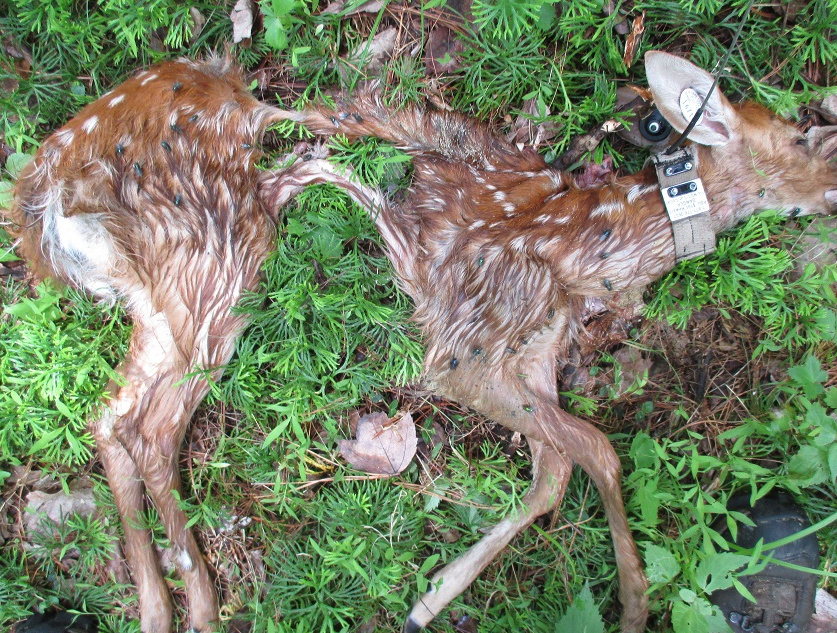My friends joke around a lot that I study death. I guess you could call me a fawn thanatologist of sorts.
Humans love to categorize and death is no exception. Of all the ways wildlife can die, they are often placed in just three categories: human-caused, predation, and natural causes that aren’t predation.
Human-caused mortality can include everything from direct causes like combine mishaps and roadkills to indirect causes like getting tangled in a fence.
Predation, of course, are the bears, bobcats, dogs, coyotes, and other sharp-toothed creatures lurking about in the night (or day!) ready to find a tasty meal.
Natural causes that don’t include predation are their own category and can starvation, disease, hypothermia, and drowning in a few inches of water (yes that happened).
For adult mammals in North America, a study in 2011 looked at all the causes of death for adult large and medium mammals and found that humans were responsible for most deaths. This was mainly the result of legal harvest.
But those are adults. What about fawns? They don’t get harvested in the summer but lots of them die.
Looking at the causes of fawn deaths listed in 29 populations studied, I calculated the proportion of fawns that died from each of the three categories: human, predation, and natural causes.
Those with the sharp teeth lead the pack. Predation followed by natural-caused deaths like starvation, disease, and abandonment ranked #2 with human-caused in last place.

Figure 1. Of fawns that died (from 29 different populations), the proportion of deaths attributed to predators, human activities, and natural causes (excluding predation).
We all know predators account for the largest portion of fawn mortality but what about the rate. Mortality rate is the opposite of survival rate. For example – if fawn survival rate is 54%, then 54% of all fawn lived and the corresponding mortality rate is 46% meaning 46% of all fawns died. These rates sum to 100%.
We break the total mortality rate into our 3 categories assigning a percentage of mortality to each.
Predation won that race as well but what was surprising was the mortality rate natural and human causes. These were statistically similar. Although natural causes killed a higher proportion of dead fawns than humans (from the first graph), the rate of mortality (proportion of total fawn population) from human causes was similar to the rate fawns died from natural causes.

Figure 2. Proportion of all fawns (in 29 different populations) that died from predators, human activities, and natural causes (excluding predation) and the proportion that survived.
Humans are the smallest source of mortality in North America for white-tailed deer fawns, but the rate fawns are dying from human sources may be greater than expected.
While humans aren’t going to cause a reduction in fawn recruitment and survival any time soon, it is a source of mortality worth noting as human impact moves into more areas.
Ok, so predation is the leading source of fawn mortality in all landscapes even agricultural. But by how much?
Can landscape influence the proportion of fawns that get eaten or run over or starve? Fawn survival is higher in landscapes with more agriculture. Which category of death does landscape influence?
Hmmmm…the plot thickens.
M.S. Graduate Student
Previous articles in this series:
Fawns, Predators, and Deer Populations-what’s the bottom line on fawn survival?
Bunches, Heaps, and Gobs of Fawns
Land of the Living
Next article in this series:
If you would like to receive email alerts of new blog posts, subscribe here.
And Follow us on Twitter @WTDresearch
